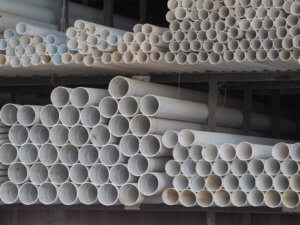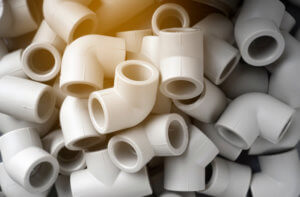When you think about CRV material recycling, you’re probably imagining glass bottles, cardboard boxes, water bottles, tin cans, and soda cans. All of these are great examples, but recycling is so much more than that! PVC is one of the most widely used plastics in the world. It is a very versatile and recyclable material as well. That’s great news for all of us!
Table of Contents
- What is PVC?
- PVC Recycling in California
- Mechanical Recycling
- Chemical Recycling
What is PVC?

PVC is an acronym that stands for Polyvinyl Chloride. PVC is a special plastic that is mostly used in construction for windows and pipes. It is also found in the automotive industry, door industry, and many other everyday products like the packaging.
There’s a reason this plastic is so widely used in our modern world. PVC is made up of 57% sea salt and 43% petroleum derivatives. This special mixture is very resistant to water, chemicals, and fire. It is also weather-resistant, easy to clean, and can last for anywhere from 30 to 50 years without beginning to break down!
Wait- if it lasts so long, is that a bad thing? Does that mean PVC sits in our landfills for decades? Actually, no! PVC recycling is quite easy and profitable for companies, so PVC isn’t damaging to our environment if properly disposed of.
PVC Recycling Methods in California

PVC became widely used a few decades ago. This means that more PVC products are reaching their end-of-life in the coming months and years. The amount needing to be properly disposed of is likely to increase significantly in the near future. Not only is PVC recycling possible, but there are also two different ways it can be done. These are:
Mechanical Recycling
As the name implies, this involves a mechanical treatment of the wastes. The PVC is ground into very small particles and then cleaned. The fresh particles are ready to be remelted and remolded. This can be done either with or without fresh material to remake the same products or a totally new one.
Chemical Recycling
PVC recycling can also be accomplished with chemicals. Both pyrolysis and hydrolysis convert plastic waste into reusable components. The resulting products such as sodium chloride, calcium chloride, and hydrocarbon products are then used to produce new PVC. The resulting product can instead be used as feed for other manufacturing processes or fuel. This still counts as recycling, because it’s not going to waste.
PVC is one of the most widely used plastics in our world today. Clearly, PVC recycling should be a priority for all of us. Our environment is precious, it needs everyone’s attention. Don’t throw out any PVC you have lying around your home or commercial property. It can and should be recycled!

